Before creating your own PTO policy, use these real-world examples for inspiration.
PTO Accrual Policy Example: Stone Press
A PTO accrual policy is the policy I recommend the most. Employees accrue paid time off every pay period. Then they can use those accrued hours to take time off whenever they want.
All you have to decide is how fast people earn their PTO and what cap you want on the total earned hours.
So what does a real PTO accrual policy example look like?
We had this policy at my last company, Stone Press. Here it is.
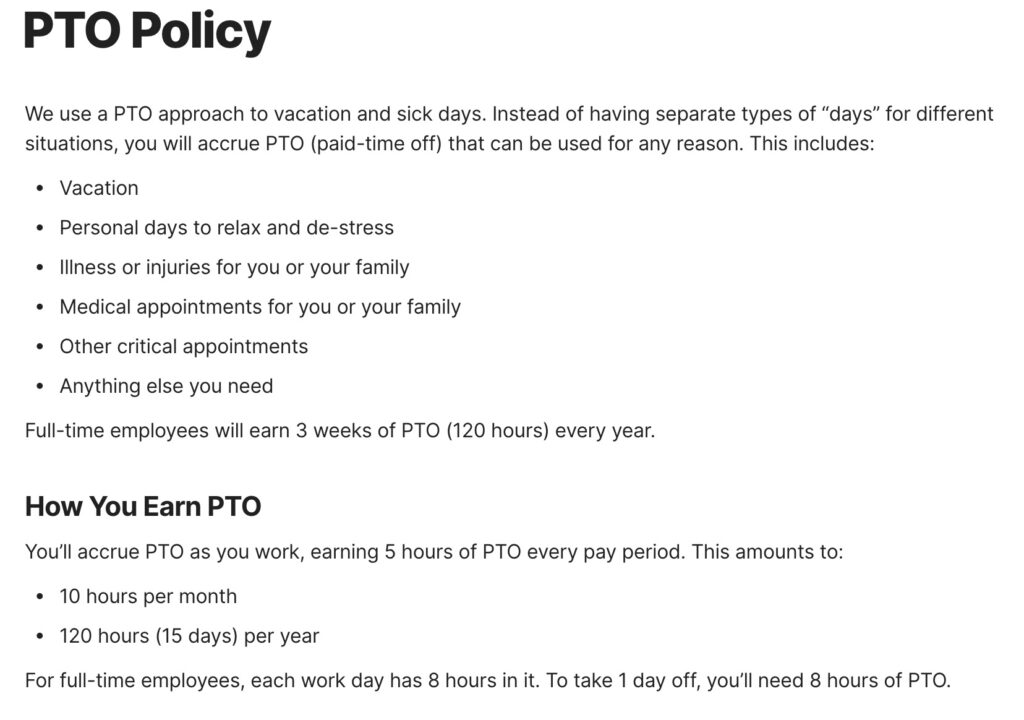
PTO can be used for anything, it accrues at 10 hours per month, and we count a workday as 8 hours. That’s the core policy, extremely simple.
There are some more details to the policy that we broke down as a FAQ section:
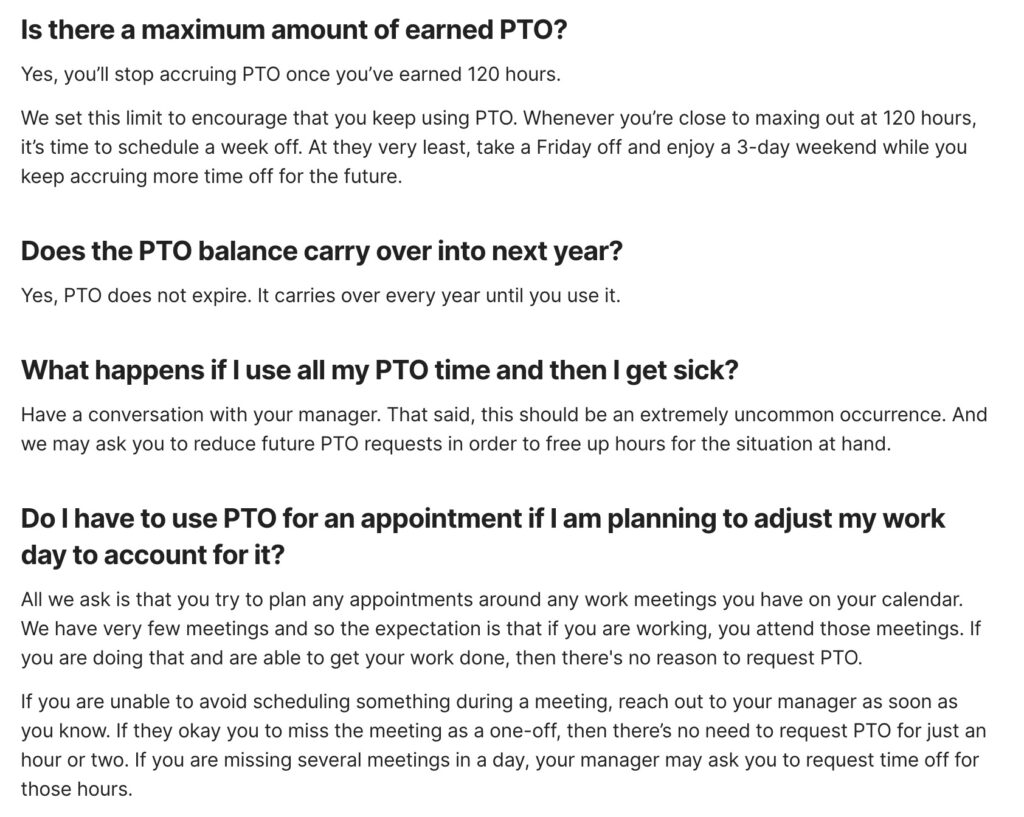
To recap:
- A maximum of 120 hours can be accrued. People need to use some of those hours if they want to keep earning PTO.
- PTO carries over each year.
- If something happens and someone doesn’t have PTO, we tell folks to talk to their manager and we handle it case-by-case.
- No need to schedule PTO for an appointment as long as it doesn’t impact ongoing meetings.
We did have a few folks struggle to keep some PTO in reserve (this can happen with folks earlier in their career), so we added this section later on:

And that’s it. The only other section we had was a quick SOP on how to put in a PTO request into our payroll software.
For any company that I’m involved with, I start with an accrual policy like this.
Options to Customize this Accrual Policy Example
There’s a few tweaks you could make to this policy.
- Adding a higher accrual cap. I recommend against this. The whole point of a cap is to encourage folks to take time off. 120 hours is a good amount in my experience. Enough that folks can bank it for something big, but not too much that they hoard their PTO.
- Increase the accrual rate. You can definitely give folks more PTO if you want. For me, I see more value in company-wide breaks (more holidays, a winter or summer break, 4-day workweeks during the summer, etc). Personal PTO has diminishing returns in my opinion. But being able to take a break when everyone else is also taking a break, that’s true rest. Personal preference though, add more if you want. I just wouldn’t do less than 120 hours per year (3 weeks per year).
- Allow folks to go negative with their PTO. We didn’t allow this. Some HR leaders believe it helps folks in an emergency. But I believe it just moves the baseline, you’ll still have the occasional emergency with someone that doesn’t have enough PTO. I’d rather keep the rule simple and address emergencies head on.
- Separating sick time from PTO. Some teams do this but I think it just adds unnecessary complexity. When people have paid time off, let them use it however they want.
- Adding a waiting period before accruals start. I think this is dumb. Accrual policies already address new hires with the core policy. Folks start at zero PTO hours and slowly build them up. There’s no reason to make new employees wait even longer. But you could do it.
- Have variable PTO accrual rates for different types of employees. Could do this by tenure. The longer you work at the company, the faster you accrue. I’m not a fan of this, I think it’s extra complexity without a ton of benefit. I’d find other ways to reward loyal employees.
Downsides of this Accrual PTO Policy Example
There’s two downsides that come up with a PTO policy like this.
The first is the implementation. Some folks get worried that tracking all the accrual rates and balances will be a headache. Any good payroll software can easily handle a PTO accrual system. It takes 15 minutes to set up and zero time to manage. Folks put in PTO requests, managers click one button to approve. If your system is struggling, it’s probably a sign that you should switch to a better payroll software.
The second downside is every employee will have a PTO balance. While a lot of states don’t require payouts, some do. Regardless, I HIGHLY recommend that you always pay out PTO. It’s standard practice in the HR industry and not worth the risk of getting a wage complaint. Also, people earned that time. Pay them for it, the total cost is so low that it doesn’t materially impact anything.
Lump Sum PTO Policy Example: Big River Steel
A lump sum (also called front-loading) PTO policy gives a batch of PTO all at once that employees can then draw from. Like 10 days on January 1st that can be used throughout the year. It’s the main alternative to an accrual system. I’ve gone into tons of details on the differences between lump sum and accrual systems here.
Big River Steel (a subsidiary of US Steel) uses a lump sum model. They call it “PTO Banks:”
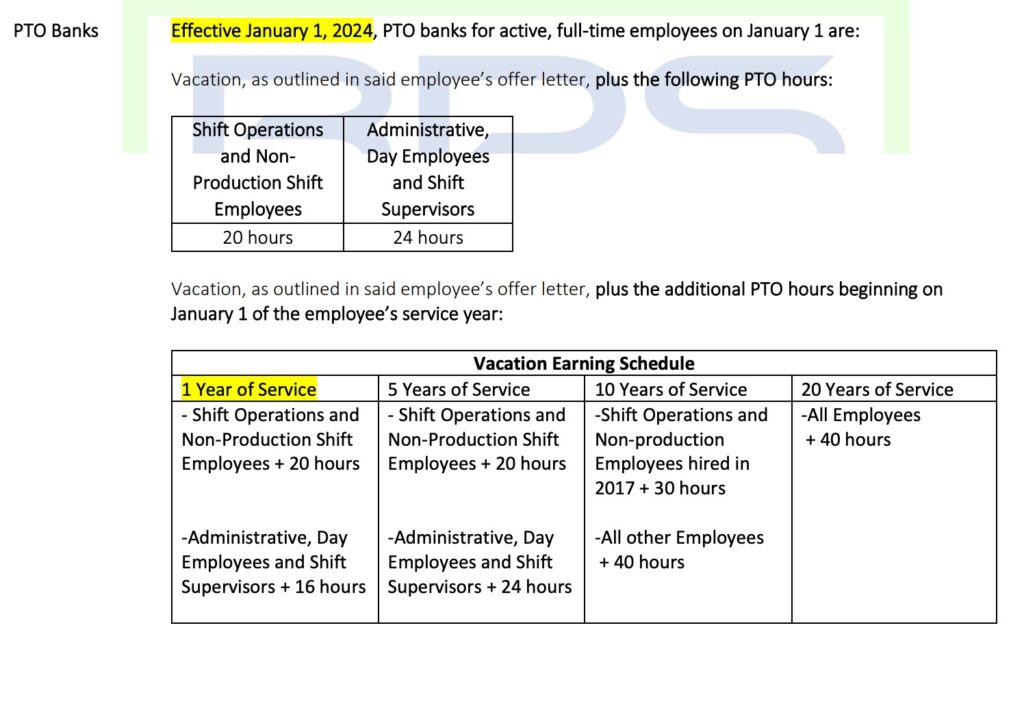
Depending on your role and tenure, you get a specific number of PTO hours on January 1st.
For new hires, they have a prorated formula to figure out how many hours the new employee receives for the partial year:

Don’t be confused by their use of “accrual,” they’re not referring to an actual PTO accrual system. It’s a prorated amount just for the first year of employment.
I do like how they handle rollovers:

I always recommend avoiding “use-it-or-lose-it” rollover policies. A few states like Colorado ban that stuff entirely. My rule: never take away PTO for any reason. That will keep you in the clear.
I’m also intrigued by how they handle buybacks:

Most companies don’t do this sort of thing, it’s a nice option to have for someone that really needs the extra cash. I do wonder if it gets used at all. A lot of times, little extras like this aren’t used at all. If it is used, I fully support it.
They do have some complicated rules around PTO payouts:
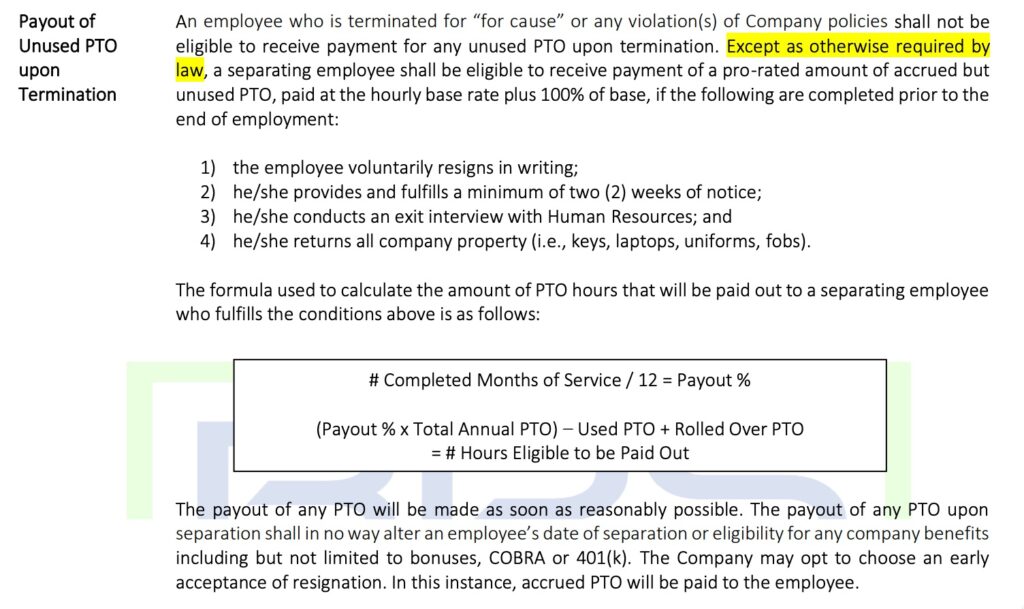
While they do pay out unused PTO, the extra stipulations irk me. Requiring a resignation to pay out unused PTO is a weird power play and can create some horrible dynamics by managers: “You know, if you were to resign, you’d get your PTO paid out in full…” That’s a horrible tone to set. If it was me, I’d pay out all unused PTO and be done with it.
Overall, this is a decent example of a lump sum PTO policy to start from.
What I Recommend Changing About this Lump Sum PTO Example
While this example of a lump sum PTO policy is a good starting point, I would make a few changes:
- Not 100% clear on how much PTO there is. Everyone gets PTO hours every year based on their tenure and role, but that’s in addition to “vacation, as outlined in the employee’s offer letter.” So does this mean everyone gets a negotiable amount of PTO? It also says this twice with 2 different tables. Do they add up or do different amounts trigger in different situations? That’s extremely complicated, and could easily become discriminatory if amounts aren’t standardized. I’d standardized this or clarify the policy.
- Give everyone the same PTO. Having admin and shift supervisors earn less PTO in year 1, then more PTO starting in year 5 is just weird. The amounts aren’t that different, why not just give the same number of hours every year? The main benefit of a lump sum model is the simplicity, why make it more complicated by having different amounts by year and role? I’d give everyone the same number of hours every year and be done with it.
- Make PTO payouts standard for everyone. PTO payouts are so small compared to the real costs of employees, it’s not material. I’d make paying out 100% of PTO standard practice for every employee. Regardless of the circumstances.
- Possibly scrap the annual PTO buyouts. I always try to simplify where I can, too many processes and teams can get locked up just trying to keep everything running. If people use it, great, keep it. But if not, I’d get rid of it.
- Possibly lower the PTO carryover amount. 200 hours is a lot, I typically use 120. My goal with PTO is to get people to take time off. Every time I’ve had someone get to 120 hours, they were definitely ready to take a vacation. Pushing someone to take a week off by the time they have 200 hours is too long to wait.
Unlimited PTO Policy Example: Autodesk
My favorite 100% unlimited PTO policy that I’ve found so far is from Autodesk:

It is truly an unlimited PTO policy (they call is discretionary time off) but it does have a few constraints:
- Managers must approve.
- Must give notice.
- The manager will consider the business, employee’s performance, and work duties.
- Time off should be reasonable.
If you want a 100% unlimited PTO policy, I’d build from this example. It strikes a nice balance between protecting the business without adding so many rules to an unlimited PTO policy that the “unlimited” part
What about Netflix’s Unlimited PTO Policy? Is that a Good Example?
Netflix is definitely the most famous unlimited PTO example.
Here’s the tricky part: during the period where they famously had unlimited PTO, they implemented it by deleting their PTO policy.
They took their old PTO policy and just… deleted it.
The policy was no policy. Tons of details are in No Rules Rules.
Apparently, that worked for them. I suspect it worked because they had a team of very high performers and were still small enough that a company could get away with policies that essentially said “be an adult.”
Would I do something like that? Not a chance. I believe having a few, clear boundaries can really help everyone work together smoothly.
If you try this yourself, definitely let me know how it goes.
Mandated PTO Policy Example: Chatbooks
It’s no secret that I really hate standard unlimited PTO policies. But I’m intrigued by what Chatbooks is doing. I don’t have the full policy but their CEO did tweet some changes that they made to their unlimited PTO policy:
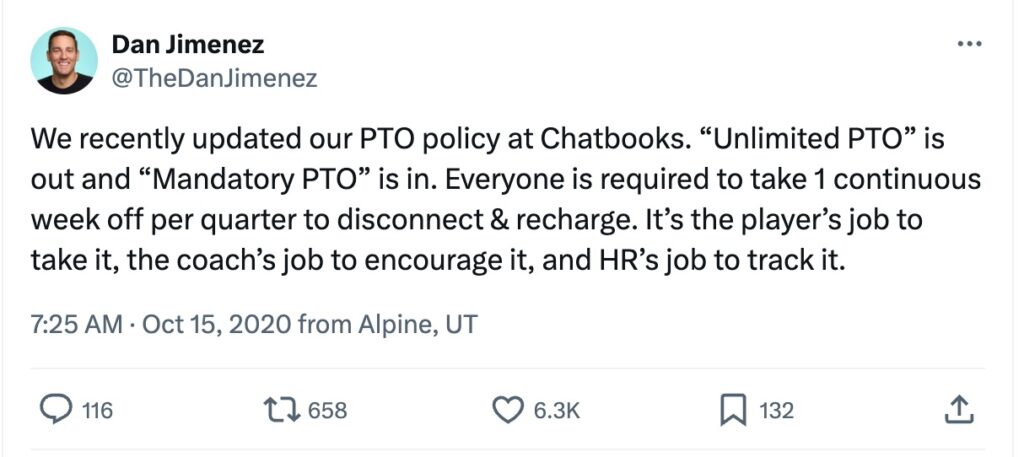
This is brilliant.
If you take a standard unlimited PTO policy, then add a mandated PTO component, you have a pretty strong policy.
- No one feels like they can’t take PTO under an unlimited PTO policy.
- Folks are getting regular breaks.
- Norms for PTO are established (1 week per quarter)
- HR can easily see who hasn’t taken PTO and can fix it.
- The “unlimited PTO” gets used for sick time, personal time, and emergencies as they come up.
Even better, you can easily add some restrictions to the unlimited PTO part (approvals, guidance on how much, making sure the business isn’t impacted, etc), and it doesn’t feel overzealous. You’re already forcing people to take 1 week off every quarter, you clearly put the employees first. Some limits on “unlimited” don’t feel off.
At this point, it’s not really an unlimited PTO policy at all, it’s a mandated PTO policy with unlimited sick leave. Does it matter what we call it though? Nope. People are getting the rest they need and can handle stuff that comes up in their lives.
If I had to use an unlimited PTO policy, I’d use this hybrid example as a starting point. Some version of this is probably the only way to do unlimited PTO without having all the typical downsides.




